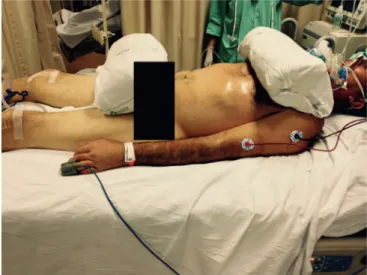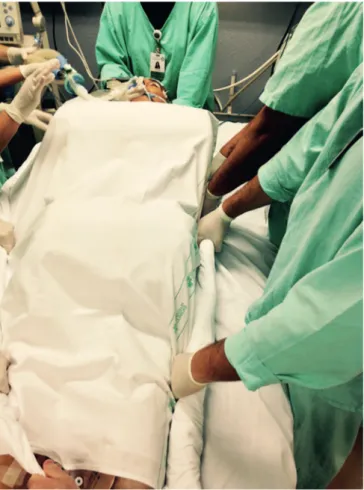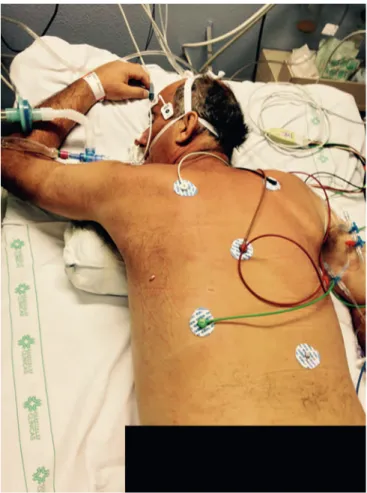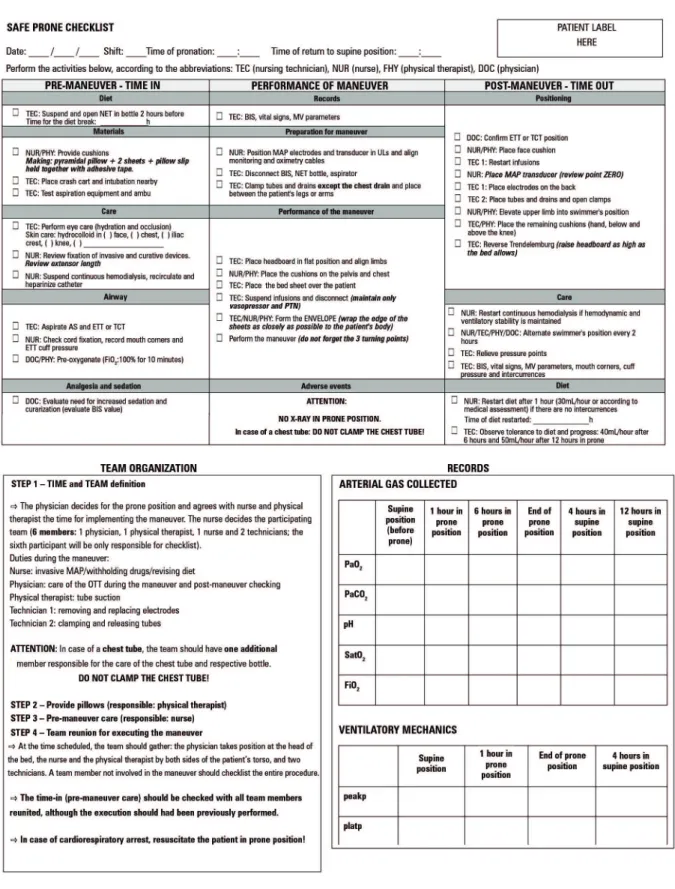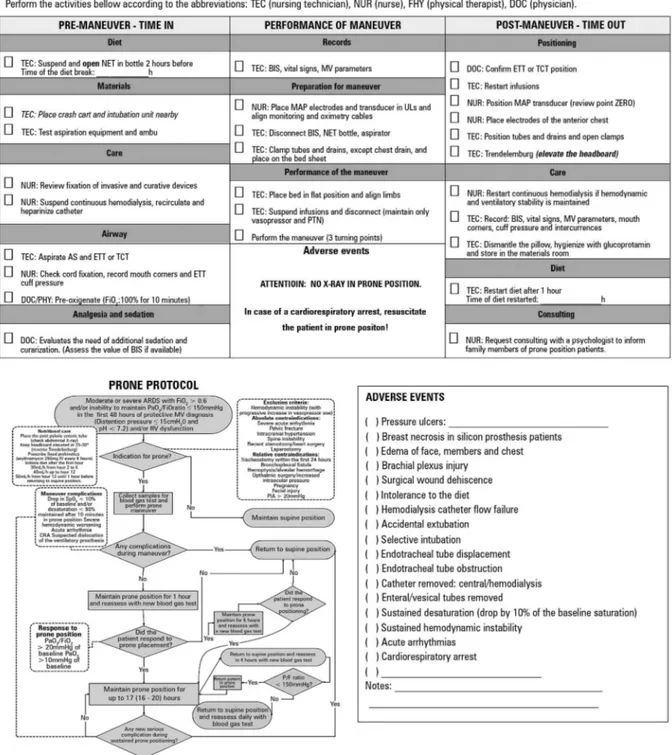Safe prone checklist: construction and
implementation of a tool for performing the
prone maneuver
INTRODUCTION
Adult respiratory distress syndrome (ARDS) has high mortality and morbidity, despite technological developments in recent decades. One of the therapies proposed for its treatment is the use of the prone position, which has been studied since 1974 and has gained popularity because it improves hypoxemia in 70% of cases.(1,2) In recent years, interest in the prone position
has resurfaced following the publication of a large randomized clinical trial that demonstrated a signiicant reduction in mortality in the pronated group.(3,4)
his inding has signiicantly increased bedside use of the prone maneuver. he maneuver is not risk-free. he incidence of complications is small (approximately three per thousand patient/days), but when complications occur they can be fatal, as in cases of central catheter extubation and avulsion. Several complications have been observed, such as pressure ulcers on the face, chest and knee; breast necrosis in patients with silicone prostheses; facial, limb and chest edema; brachial plexus injury; operative wound dehiscence; diet intolerance; accidental extubation; selectivity; endotracheal tube displacement and obstruction; removal of or diiculty of low in the hemodialysis catheter and other catheters; and the removal of enteral and vesical catheters.(4,5)
he most common complications are pressure ulcers, mechanical ventilation-associated pneumonia and endotracheal tube obstruction or decannulation. Vanessa Martins Oliveira1, Daniele Martins
Piekala1, Gracieli Nadalon Deponti1, Danusa Cassiana Rigo Batista1, Sílvia Daniela Minossi1, Marcele Chisté1, Patrícia Maurello Neves Bairros1, Wagner da Silva Naue1, Dulce Inês Welter1, Sílvia Regina Rios Vieira2
1. Intensive Care Unit, Hospital de Clínicas de Porto Alegre - Porto Alegre (RS), Brazil. 2. Universidade Federal do Rio Grande do Sul -
Porto Alegre (RS), Brazil. implement an instrument (checklist) Objective: To construct and
to improve safety when performing the prone maneuver.
Methods: his was an applied, qualitative and descriptive study. he instrument was developed based on a broad review of the literature pertaining to the construction of a care protocol using the main electronic databases (MEDLINE, LILACS and Cochrane).
Results: We describe the construction of a patient safety tool with numerous
Conflicts of interest: None.
Submitted on July 28, 2016 Accepted on October 8, 2016
Corresponding author:
Vanessa Martins Oliveira
Unidade de Terapia Intensiva do Hospital de Clínicas de Porto Alegre
Rua Ramiro Barcelos, 2.350
Zip code: 90035-903 - Porto Alegre (RS), Brazil E-mail: vanessa.oliveira480@gmail.com
Responsible editor: Alexandre Biasi Cavalcanti
Checklist da prona segura: construção e implementação de uma
ferramenta para realização da manobra de prona
ABSTRACT
Keywords: Respiratory distress syndrome, adult; Prone position/methods; Pronation/methods; Respiratory failure; Check list; Patient safety; Inservice training modiications and adaptations based on the observations of the multidisciplinary team regarding its use in daily practice.
Conclusion: he use of the checklist when performing the prone maneuver increased the safety and reliability of the procedure. he team’s understanding of the tool’s importance to patient safety and training in its use are necessary for its success.
he most serious fatal event is accidental extubation, which is rare (zero to 2.4% prevalence).(4-7) A recent
meta-analysis of the safety and eicacy of the maneuver showed that patients who were pronated had an increased risk of pressure ulcers, endotracheal tube displacement and tracheostomy. However, no signiicant diferences were observed in the occurrence of other complications, such as cardiovascular events or ventilation-associated pneumonia.(8)
hese results suggest that the procedure is safe and inexpensive but requires teamwork and skill. hus, centers with less experience may have diiculty managing complications, but nursing care protocols and guidelines can mitigate this risk.(8) Reports in the literature suggest
that the incidence of adverse events is signiicantly reduced in the presence of trained and experienced staf, which makes the maneuver safe.(9-12)
An analysis of existing studies reveals some important considerations for clinical practice regarding the need to organize the pronation process. hus, this study proposes to construct and implement a tool in a checklist format to standardize the process and make the prone procedure safe.(13) Checklists are have been used for many decades in
aviation, civil construction and other non-medical areas to guide users when completing tasks in which errors or omissions can be fatal. he application of checklists reduces errors of omission and the improper application of procedures and protocols and creates reliable and reproducible evaluations.(14-16) Similar to light and
military crews, health professionals must often analyze and manage stressful and fatiguing situations.(17) herefore, in
recent years, checklists have also been applied in the health ield to improve the quality of medical care.(18) here are
several examples of the successful application of checklists in health care areas that require systematic and rapid approaches, such as anesthesiology, surgery, emergency treatment and intensive care.(18,19)
he objective of this study was to construct and implement an instrument (checklist) to improve care when performing the prone maneuver.
METHODS
his was a descriptive, applied, narrative, experience-reporting study that aimed to describe the process developed by the Pronation Teaching and Research Group (Grupo de Ensino e Pesquisa em Prona - PEP-PRONA) at a teaching hospital in the city of Porto Alegre, Rio Grande do Sul State (RS), Brazil.
he study was conducted in the intensive care center of the Hospital de Clínicas de Porto Alegre starting in the second half of 2015 and was approved by the Ethics Committee (CAAE 61274316.1.0000.5327). he institution’s intensive care unit comprises 44 clinical and surgical beds and has a mean hospitalization of 1,800 patients/year. his health organization was chosen mainly due to the presence of a multidisciplinary group composed of physicians, physical therapists, nutritionists and nurses. he group was created in 2012 to implement a protocol for the prone maneuver.
Following a protocol instituted in 2014 that was accompanied by team training with realistic simulation techniques, the need for improvements in the process was identiied (Figure 1). he objective was to improve the eicacy of care and patient safety; therefore, the creation of a bedside checklist was proposed. his study describes the standardization of the checklist, its application in the procedure, the diiculties encountered in the process, and the changes made during the tool’s construction.
he instrument was based on a care protocol(20) that
was constructed on the basis of a broad review of the literature identiied with a thorough search of the main electronic databases (MEDLINE, Latin American and Caribbean Health Sciences Literature [Literatura Latino-Americana e do Caribe em Ciências da Saúde - LILACS] and COCHRANE) for the period between January 1995 and March 2016. Original studies or reviews were included, without language restrictions. Studies involving patients under 18 years of age or animals were excluded.(20)
he following descriptors were used: ((“prone position” [MeSH Terms]) OR Prone [TextWord]) OR prone [Text Word]) OR proning [Text Word])) AND ((“Intensive Care” [Mesh]) OR “Intensive Care” [Text Word]) AND
(“Respiratory Distress Syndrome, Adult” [MeSH Terms]) OR Respiratory Distress Syndrome, Adult [Text Word]) OR
ARDS [Text Word]).(20)
he checklist was developed and improved during care for ten patients with moderate and severe ARDS who were subjected to the prone maneuver in the intensive care unit between June 2015 and April 2016. On average, two prone sessions per patient and two supine sessions per patient were performed. he mean time spent in the prone position in each session was 17 hours.
he original instrument required several modiications over time based on the experience gained from the innumerable performances of the maneuver at bedside.
Figure 1 - Flow diagram of the prone position care protocol. ARDS - adult respiratory distress syndrome; FiO2 - inspired oxygen fraction; PaO2 - partial oxygen pressure; MV - mechanical ventilation; IV: intravenous; RV - right ventricle; PIA - intra-abdominal pressure; SpO2 - oxygen saturation; CRA - cardiorespiratory arrest; P/F - ratio of partial oxygen pressure
Table 1 - Development of the instrument over time
Description First version Second version Third version Fourth version
Modifications to the instrument suggested by the multidisciplinary team over time
All care was described in sequence without division into pre-, during and post-maneuver activities (standard operating procedure)
There were no check boxes for items The tool was not included in the patient folder
The instrument was read by a team member involved in the maneuver The team members participating in the process were not specified in advance
Care was separated into pre-, during and post-maneuver periods
The checklist’s layout was similar to that of the safe surgery checklist but without boxes to check
Item check boxes were implemented
The boxes were still checked by the team members themselves Header with information about the time of pronation and time of return to supine position was added, facilitating the organization of the team It was determined that the instrument should remain in the patient's folder
It was determined that before the application of the tool, team members should determine the times of pronation and return to supine position
Written guidelines considered most relevant to the process’s safety were bolded
Space for the description of adverse events was added
RESULTS
Some modiications were proposed in the inal version of the instrument with the determination of four steps that should be followed at bedside before starting the checklist.
Step 1: time and team definition (responsible: physician, nurse and physical therapist)
he physician deines the need for performing the prone maneuver and, together with the nurse and physiotherapist, determines the time of the maneuver and identiies the members of the prone team by name. he team should comprise six members: a physician, a physical therapist, a nurse, two technicians, and a physical therapist or nurse or technician responsible for reading and checking all checklist items. he person responsible for reading the tool should not participate in the procedure. In the case of patients with a chest drain, the team should include one more member, who is responsible for taking care of the drain and bottle.
We recommend that X-rays not be performed in the prone position due to the risk-beneit ratio; namely, the risk of catheter and endotracheal tube avulsion during the examination. Moreover, in this position, interpretation of the results is impaired as most professionals are not accustomed to interpreting images in other positions. Alternatively, thoracic echography can be performed to evaluate the pulmonary parenchyma and catheter position.(20)
Step 2:provide cushions (responsible: physical therapist)
Once the need for the maneuver has been identiied, the physiotherapist prepares or provides cushions to support the face, chest, pelvis, wrists and anterior leg region (Figure 2).
Figure 2 - Cushions for face, chest, pelvis and wrist.
Step 3: pre-maneuver care (responsible: nurse)
he nurse performs the time-in (pre-maneuver care) steps, which are checked when the whole team is assembled.
Step 4: team assembles to perform the maneuver
At the time predetermined by the team, all the designated professionals must assemble. he physician be positioned at the head of the bed to coordinate the rotation and to promptly reintubate the patient in case of accidental extubation. he nurse and physical therapist should stand on each side of the patient’s trunk. Two technicians should position themselves on either side of the patient, next to the legs.(20) In the case of an obese
patient, two more people can be added to the team. A team member who is not involved in the maneuver should perform the checklist.
Figure 3 - Placement of the cushions on the chest and pelvis before the envelope maneuver is performed.
Figure 4 - Envelope Maneuver. Step 1: Position the top sheet over the lower sheet. Place drains, tubes and invasive pressure transducer inside the envelope. Pre-maneuver care
he nurse and the technician perform some tasks before the designated time for commencing the maneuver. hese tasks should be checked again at checklist time. he tasks are divided into nutritional care (suspend feeding and open the nasoenteric tube 2 hours before the procedure); material care (provide cushions; place the crash cart and intubation unit close by; test aspiration equipment and bag-valve-mask device [AMBU]); general care (provide eye and skin care, review the ixation of invasive and curative devices, suspend continuous hemodialysis [recirculate and heparinize catheter]); airway care (airway aspiration; check ixation of the cord; record mouth corners and cuf pressure of the endotracheal tube; pre-oxygenate the patient with inspired oxygen fraction - FiO2: 100% for 10 minutes); and analgesia and sedation care (assess the need for increased sedation and curarization [evaluate the bispectral (BIS) index value, when available]).(5,20)
In the irst version of the tool, the nurse’s and physiotherapist’s actions at the beginning of the maneuver, when the team positions itself and the checklist is performed again, were not determined, nor was the care performed prior to the beginning of the maneuver. However, separating the tasks and taking these precautions before beginning the maneuver expedites the procedure time. In the initial tool, the items were verbally checked but not conirmed with the team as a whole or annotated. he instrument was read by a team member involved in the maneuver. By checking at the time of the maneuver, when all the professionals are in position, and having another professional read the checklist aloud and marks each checked item, we observed a gain in time and organization and found that more attention was paid to the process.
Care in the performance of the maneuver
Before the maneuver is performed, the second part of the checklistis applied (conirmation). It is conirmed that the entire team is in the correct position (physician at the headboard and the other group members distributed along the two sides of the bed) and that everyone knows the envelope maneuver and the three turning points. he tool is then read, and the signal readings for the maneuver (place invasive blood pressure electrodes and transducer on the upper limbs and align monitoring and oximetry cables; disconnect BIS ventilator if in use; disconnect the nasoenteric tube from the bottle and close; disconnect the aspirator; clamp tubes and drains and place them
between the patient’s legs or arms) are checked. Next, the performance procedures are read aloud (place head in a lat position and align limbs, position the pelvis and chest cushions, and suspend and disconnect infusions), and the envelope is formed (Figures 3 to 5).(4,5,20)
he three-point turn is performed on the physician’s command.(20) he patient must be moved to the side of
the bed opposite the mechanical ventilator, placed in lateral position, and then turned to the prone position. (Figures 4 to 8).
Figure 5 - Envelope Maneuver. Step 2: Join and wrap the top and bottom sheet as closely as possible to the patient's body.
Figure 6 - Envelope Maneuver. Step 3: Start turning the patient on the physician's command. Move the patient to the side of the bed opposite the mechanical ventilator.
Figure 7 - Envelope Maneuver. Step 4: Turn the patient to lateral position. Perform the hand exchange maneuver among the team by placing one hand on the left side and one on the right side of the patient.
Post-maneuver care
After the procedure, with the patient already in the prone position, the positioning of the endotracheal tube by pulmonary auscultation and mouth corners is checked. he tube cuf pressure is conirmed. It is also necessary to check the position of the pelvis and anterior chest cushions, ensuring that the abdomen is free, and to check the positioning of the other cushions: face (avoiding eye and ear injuries and breakage of the endotracheal tube), hand, and anterior leg region (Figure 9).(4,6,20)
he position of the headboard (reverse Trendelenburg) is checked to reduce the risk of aspiration. he invasive arterial pressure transducer and electrodes on the patient’s chest must be repositioned. he upper limb is raised into the swimmer’s position and alternated every 2 hours to avoid injury to the brachial plexus (Figure 10).(4-6,20)
Parenteral infusion and hemodialysis drugs, if used, are restarted. Pressure points are relieved, especially in the iliac crests and knees. Vital signs are again recorded, and the re-initiation of enteral feeding is re-evaluated during the second hour in prone position if there are no complications (Figure 11).(20)
Figure 10 - Swimmer's position (one arm raised and head rotated toward the raised arm; the other arm is positioned alongside the body).
Figure 8 - Envelope Maneuver. Step 5: End of rotation and prone positioning and start of post-maneuver care.
Figure 9 - Post-maneuver care (check the placement of the cushions, keeping the abdomen free).
herefore, to facilitate the process, a checklist was proposedfor returning the patient to the supine position (Figure 12).
We observed that the team had great diiculty agreeing on a time to return the patient to the supine position. herefore, we included the time that prone began and the time at which the patient should be supinated on the form header. his decision should be made by the team when it is together (preferably during the day) considering a range of 17 - 20 hours in prone position, as suggested by the literature.(3) he date and time of pronation and date and
time of return to the supine position should be recorded on the header of both the safe prone and supine position checklists.
To apply the latest version of the checklist,the team was previously trained using realistic simulation techniques and a focus group to develop technical skills and team control in emergency situations.
DISCUSSION
Checklists are among the many tools used in practice to support the multidisciplinary team. Checklist use increases process safety by organizing the basic criteria to follow and condensing a large amount of knowledge into a concise format.(21,22) Essential criteria that the user
of a particular process must remember should be included in the tool to increase the objectivity of the process’s evaluation and reproducibility.(23,24)
his tool is a perfect it for the prone maneuver as this procedure is not frequently applied in daily practice and requires numerous precautions that, if forgotten or performed poorly, can endanger the patient.
Figure 11 - Latest version of the safe prone maneuver checklist (time in, performance of maneuver and time out). Front and back of the sheet with guidelines for the team and prone protocol in flowchart format. NET - nasoenteric tube; BIS - bispectral index; MV - mechanical ventilation; ETT - endotracheal tube; TCT - tracheostomy; FiO2 - inspired fraction of oxygen; MAP - invasive mean arterial pressure; ULs- upper limbs; PTN - parenteral nutrition; AS - airways; PaO2 - partial oxygen pressure; PaCO2 - partial carbon
Figure 12 - Front and back of the checklist for return to supine position. NET - nasoenteric tube; BIS - bispectral index; MV - mechanical ventilation; ETT - endotracheal tube; TCT - tracheostomy; MAP - invasive mean arterial pressure; ULs - upper limbs; PTN - parenteral nutrition; AS - airways; FiO2 - inspired oxygen fraction; ARDS - adult respiratory distress syndrome; RV -
Objetivo: Construir e implementar um instrumento (checklist) para melhoria do cuidado na manobra prona.
Métodos: Estudo aplicativo, qualitativo e descritivo. O ins-trumento foi desenvolvido a partir de ampla revisão da litera-tura, para construção de um protocolo de atendimento assis-tencial, utilizando as principais bases eletrônicas (MEDLINE, LILACS e Cochrane).
Resultados: Descrevemos a construção de uma ferramenta de segurança do paciente com suas inúmeras modiicações e adaptações, a partir das observações da equipe multidisciplinar com seu uso na prática diária.
Conclusão: A aplicação do checklist na manobra de prona acrescentou coniabilidade e segurança ao procedimento. O entendimento da importância da ferramenta na segurança do paciente, por parte da equipe, e sua capacitação são necessários para seu sucesso.
RESUMO
Descritores: Síndrome do desconforto respiratório do adul-to; Decúbito ventral/métodos; Pronação/métodos; Insuiciência respiratória; Lista de checagem; Segurança do paciente; Capaci-tação em serviço
REFERENCES
1. Bryan AC. Conference on the scientific basis of respiratory therapy. Pulmonary physiotherapy in the pediatric age group. Comments of a devil´s advocate. Am Rev Resp Dis. 1974;110(6 Pt 2):143-4.
2. Taccone P, Pesenti A, Latini R, Polli F, Vagginelli F, Mietto C, Caspani L, Raimondi F, Bordone G, Iapichino G, Mancebo J, Guérin C, Ayzac L, Blanch L, Fumagalli R, Tognoni G, Gattinoni L; Prone Supine II Study Group. Prone positioning in patients with moderate and severe acute respiratory distress syndrome: a randomized controlled trial. JAMA. 2009;302(18):1977-84. 3. Guérin C, Reignier J, Richard JC, Beuret P, Gacouin A, Boulain T, Mercier
E, Badet M, Mercat A, Baudin O, Clavel M, Chatellier D, Jaber S, Rosselli S, Mancebo J, Sirodot M, Hilbert G, Bengler C, Richecoeur J, Gainnier M, Bayle F, Bourdin G, Leray V, Girard R, Baboi L, Ayzac L; PROSEVA Study Group. Prone positioning in severe acute respiratory distress syndrome. N Engl J Med. 2013;368(23):2159-68.
4. Ball C, Adams J, Boyce S, Robinson P. Clinical guidelines for the use of the prone position in acute respiratory distress syndrome. Intensive Crit Care Nurs. 2001;17(2):94-104.
5. Dirkes S, Dickinson S, Havey R, O’brien D. Prone positioning: is it safe and effective? Crit Care Nurs Q. 2012;35(1): 64-75.
6. Rowe C. Development of clinical guidelines for prone positioning in critically ill adults. Nurs Crit Care. 2004;9(2):50-7.
7. Marion BS. A turn for the better: ‘prone positioning’ of patients with ARDS. Am J Nurs. 2001;101(5):26-34; quiz 34-5.
8. Park SY, Kim HJ, Yoo KH, Park YB, Kim SW, Lee SJ, et al. The efficacy and safety of prone positioning in adults patients with acute respiratory distress syndrome: a meta-analysis of randomized controlled trials. J Thorac Dis. 2015;7(3):356-67.
9. Lee JM, Bae W, Lee YJ, Cho YJ. The efficacy and safety of prone positional ventilation in acute respiratory distress syndrome: updated study-level meta-analysis of 11 randomized controlled trials. Crit Care Med. 2014;42(5):1252-62.
excessively lengthy. herefore, the careful selection of checklist topics and consideration of clinical judgment in content construction are necessary.(22,23) It is important
to consider that checklists are not appropriate in all environments and should be used for tasks that are prone to error or omission to improve accuracy, adherence to best practices and the reliability of the process.
he list should be easy and practical, giving health professionals the freedom to use their clinical judgment. It should not interfere with patient care time. he checklist should be reviewed frequently to ensure that it relects the diiculties that the team encounters in practice and to perform updates based on current evidence from the literature.(22,23)
More than a list, the checklist is a tool that should be built by the team, and only items that add value to the process should be included. A major challenge at bedside is overcoming the stigma that checklists are an imposition; the group should be shown that the use of the checklist contributes to patient safety. he fact that the team is
aware of the checklist does not mean that it knows how to use it. he reason the checklist should be used and how to use it properly should be shown to all team members through training.(22,23) Repeated application of this tool
is important to identify team diiculties and to suggest improvements to the instrument.
CONCLUSION
he application of the checklist when performing the prone maneuver made the maneuver safer and more reliable. It is necessary to involve the entire team in the check so that everyone respects each of the items on the list and is aware that performing them is essential to the success of the maneuver. Communication is central to success, and the checklistmakes this happen in the best possible way.
10. Girard R, Baboi L, Ayzac L, Richard JC, Guérin C; Proseva trial group. The impact of patient positioning on pressure ulcers in patients with severe ARDS: results from a multicentre randomised controlled trial on prone positioning. Intensive Care Med. 2014;40(3):397-403.
11. Sud S, Friedrich JO, Adhikari NK, Taccone P, Manebo J, Polli F, et al. Effect of prone positioning during mechanical ventilation on mortality among patients with acute respiratory distress syndrome: a systematic review and meta-analysis. CMAJ. 2014;186(10):E381-90. Review.
12. Gattinoni L, Taccone P, Carlesso E, Marini JJ. Prone position in acute respiratory distress syndrome. Rationale, indications, and limits. Am J Respir Crit Care Med. 2013;188(11):1286-93.
13. Sexton JB, Thomas EJ, Helmreich RL. Error, stress, and teamwork in me-dicine and aviation: cross sectional surveys. BMJ. 2000;320(7237):745-9. 14. Wolff AM, Taylor SA, McCabe JF. Using checklists and reminders in
clinical pathways to improve hospital inpatient care. Med J Aust. 2004;181(8):428-31.
15. Young GB, Frewen T, Barr HW, Hinton GG, Blume WT, Kronick JB, et al. Checklist for diagnosis of brain death. Can J Neurol Sci. 1991;18(1):104. 16. Hall RI, Rocker GM, Murray D. Simple changes can improve conduct of
end-of-life care in the intensive care unit. Can J Anaesth. 2004;51(6):631-6.
17. Vincent JL. Give your patient a fast hug (at least) once a day. Crit Care Med. 2005;33(6):1225-9.
18. Pronovost P, Berenholtz S, Dorman T, Lipsett PA, Simmonds T, Haraden C. Improving communication in the ICU using daily goals. J Crit Care. 2003;18(2):71-5.
19. Pronovost PJ, Rinke ML, Emery K, Dennison C, Blackledge C, Berenholtz SM. Interventions to reduce mortality among patients treated in intensive care units. J Crit Care. 2004;19(3):158-64.
20. Oliveira VM, Weschenfelder ME, Deponti G, Condessa R, Loss SH, Bairros PM, et al. Good practices for prone positioning at the bedside: Construction of a care protocol. Rev Assoc Med Bras (1992). 2016;62(3):287-93. 21. Morrow DG, Leirer VO, Andrassy JM, Hier CM, Menard WE. The influence
of list format and category headers on age differences in understanding medication instructions. Exp Aging Res. 1998;24(3):231-566.
22. Hales B, Terblanche M, Fowler R, Sibbald W. Development of medical checklists for improved quality of patient care. Int J Qual Health Care. 2008;20(1):22-30.
23. Scriven M. The logic and methodology of checklists [dissertation]. Claremont, CA: Claremont Graduate University; 2000.


